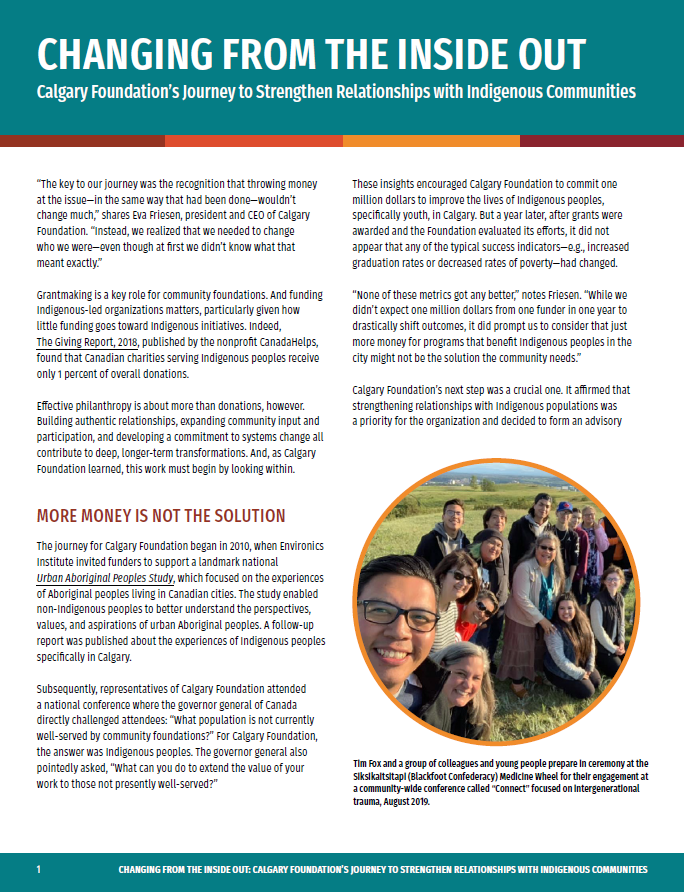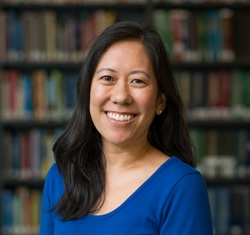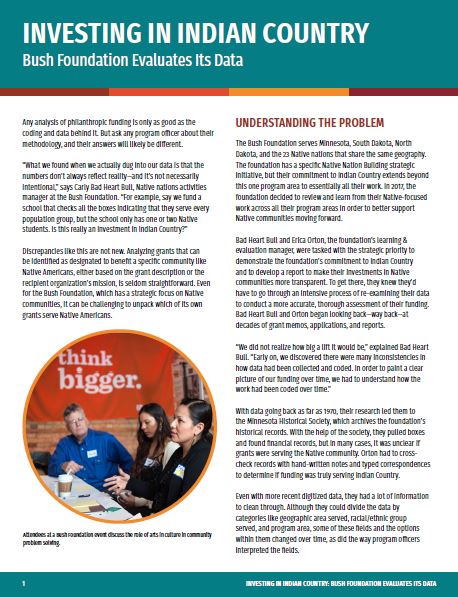Changing from the Inside Out: Calgary Foundation’s Journey to Strengthen Relationships with Indigenous Communities
This case study has been developed as a part of Investing in Native Communities, a joint project of Candid and Native Americans in Philanthropy.
“The key to our journey was the recognition that throwing money at the issue—in the same way that had been done—wouldn’t change much,” shares Eva Friesen, president and CEO of Calgary Foundation. “Instead, we realized that we needed to change who we were—even though at first we didn’t know what that meant exactly.”
Grantmaking is a key role for community foundations. And funding Indigenous-led organizations matters, particularly given how little funding goes toward Indigenous initiatives. Indeed, The Giving Report, 2018, published by the nonprofit CanadaHelps, found that Canadian charities serving Indigenous peoples receive only 1 percent of overall donations.
Effective philanthropy is about more than donations, however. Building authentic relationships, expanding community input and participation, and developing a commitment to systems change all contribute to deep, longer-term transformations. And, as Calgary Foundation learned, this work must begin by looking within.
More Money Is Not the Solution
The journey for Calgary Foundation began in 2010, when Environics Institute invited funders to support a landmark national Urban Aboriginal Peoples Study, which focused on the experiences of Aboriginal peoples living in Canadian cities. The study enabled
non-Indigenous peoples to better understand the perspectives, values, and aspirations of urban Aboriginal peoples. A follow-up report was published about the experiences of Indigenous peoples specifically in Calgary.
Subsequently, representatives of Calgary Foundation attended a national conference where the governor general of Canada directly challenged attendees: “What population is not currently well-served by community foundations?” For Calgary Foundation, the answer was Indigenous peoples. The governor general also pointedly asked, “What can you do to extend the value of your work to those not presently well-served?”
These insights encouraged Calgary Foundation to commit one million dollars to improve the lives of Indigenous peoples, specifically youth, in Calgary. But a year later, after grants were awarded and the Foundation evaluated its efforts, it did not appear that any of the typical success indicators—e.g., increased graduation rates or decreased rates of poverty—had changed.
“None of these metrics got any better,” notes Friesen. “While we didn’t expect one million dollars from one funder in one year to drastically shift outcomes, it did prompt us to consider that just more money for programs that benefit Indigenous peoples in the city might not be the solution the community needs.”
 Calgary Foundation’s next step was a crucial one. It affirmed that strengthening relationships with Indigenous populations was a priority for the organization and decided to form an advisory group of Indigenous leaders from Calgary to inform its next steps. Following a year of conversation and community engagement, the Foundation decided to hire someone to lead the work within the organization. A senior leader was hired, not to be the head of an Indigenous grants program, but to lead change within the organization with an Indigenous perspective and knowledge. The Foundation wanted to change who it was from the inside out. “We didn’t know what this would look like. We didn’t know where it was going,” admits Friesen. “We don’t know what we don’t know. But that was okay. We needed to be brave.”
Calgary Foundation’s next step was a crucial one. It affirmed that strengthening relationships with Indigenous populations was a priority for the organization and decided to form an advisory group of Indigenous leaders from Calgary to inform its next steps. Following a year of conversation and community engagement, the Foundation decided to hire someone to lead the work within the organization. A senior leader was hired, not to be the head of an Indigenous grants program, but to lead change within the organization with an Indigenous perspective and knowledge. The Foundation wanted to change who it was from the inside out. “We didn’t know what this would look like. We didn’t know where it was going,” admits Friesen. “We don’t know what we don’t know. But that was okay. We needed to be brave.”
A New Way of Seeing
In 2017, Calgary Foundation welcomed Tim Fox, a proud member of the Blackfoot Confederacy from the Blood (Kainai) reserve, as vice president of Indigenous relations. His mandate was broad but simple: “Teach us what we don’t know; show us a new way of seeing things.”
Fox approaches the work of reconciliation through systems change. His role not only focuses on ensuring that Indigenous initiatives receive funding, it’s also about designing new knowledge systems to help the Foundation understand why systemic disadvantages exist for Indigenous communities in the first place. “I was literally tasked to facilitate a change process and find ways to shift the culture of an organization and mobilize the Truth and Reconciliation Commission’s calls to action. I quickly came to realize, there is no guidebook for this work. I also knew that before any shifts can begin to happen or any change can be realized, there is a level of context that is missing. I wanted to take the entire team—including board, staff, and volunteers—through
experiences that increase their knowledge,” shares Fox. “There is a common thought pattern about the Indigenous community that is very negative. We need to understand how history has led us to where we are now and how this thought pattern continues to cause harm for Indigenous communities.”
He has approached this work in a variety of ways, designing knowledge sharing based on themes he feels are important for his colleagues to understand. One of the ways he shares this is through a workshop he designed called Impacts of Intergenerational Trauma. This engaging experience touches on realities Indigenous communities currently face and explores the legacy that historical processes and policies continue to have on Indigenous peoples.
Fox also facilitates the Blanket Exercise for all stakeholders, which was a practice Calgary Foundation’s board initiated before he came on board. This interactive history telling guides participants through history from an Indigenous perspective. The goal is to foster truth, understanding, and reconciliation among Indigenous and non-Indigenous peoples.(1)
Another theme that has emerged focuses on Indigenous women and girls. In June 2019, following a three-year national inquiry into the widespread deaths and disappearances of Indigenous women and girls in Canada, a landmark government report pointedly named “persistent and deliberate human and Indigenous rights violations and abuses” as the root cause of this “genocide.” “We’re going to take some time to slow down and to unpack what that means and really understand the issue,” says Fox. “Things will then begin to emerge in how we grant or how we support charities that support Indigenous women and girls. And from there, more things will continue to emerge.”
Fox creates space and comfort in the Foundation to lean into topics as they arise. He recognizes that this process of learning, unlearning, unpacking, and understanding must happen throughout the entire organization. “It doesn’t matter what role you hold, we all have a responsibility to be a part of change,” says Fox. “It wouldn’t be enough to focus, for example, just on the programs team and spend all my time increasing their knowledge capacity. This would create a dynamic where only a select group of people hold knowledge, and it would be difficult for them to incorporate changes that the rest of the organization wouldn’t fully understand. So, it’s important that everyone in the organization gets to the same level of understanding.”
To that end, Fox has also organized staff retreats inspired by the Art of Hosting and systems change methodologies. These retreats take place on the land with a facilitation team that includes Indigenous elders, Indigenous and non-Indigenous facilitators, and storytellers. This is an intensive learning experience that engages participants in conversation about many topics but is rooted in the framework of reconciliation. This unique experience provides each person with an opportunity to develop personal leadership and capacity to facilitate and lead both dialogue and engagement in complex situations. It is an effective way of harnessing the collective wisdom and self-organizing capacity of groups and designing collaborative projects with impact. Staff of Calgary Foundation are joined by staff of a partner charity also committed to reconciliation, facilitating further relationship building, knowledge exchange, and change ideologies. The retreats enable participants to identify what their own work means for Indigenous communities and how they can navigate their journey of reconciliation.
The feedback from staff who have attended these retreats has been positive. One participant reflected, “By far, the most impactful insight was that I need not be ashamed or afraid of that which I do not know. This is a journey—with no destination—and each step I take is a step in the right direction. I will never have all the answers and may still say things that are wrong or misguided, but even in those instances there are learnings if I am open to seeing them.”
Just as everyone is afforded the opportunity to learn, all staff are also held accountable for their learning. In 2019, for the first time, the organization added to its annual performance evaluation the responsibility for staff to identify an area of learning tied to strengthening relationships with Indigenous communities. All staff have self-identified a goal related to reconciliation, alongside other role-related performance goals.
For his part, Fox is responsible for communicating opportunities for staff to engage with Indigenous communities. He also makes himself available for one-on-one consultation, although most have not requested this support. Fox shares that “there are so many things happening, and so many opportunities coming up. Staff are at a level of knowledge where they’re confident that they know what they want to do and what they want to focus on.” Some are even making it personal. For example, one peer is using it as an opportunity to connect with family members who identify as Indigenous.
Fox and Friesen are eager to see how Foundation staff have met these goals and how the Foundation can continue to support staff development. “This journey should begin with an individual shift that hopefully informs and influences the practice of that individual in the workplace, thus leading to more significant shifts within the organization or system,” describes Fox. “Fundamentally, what was very important was the realization that we need to change ourselves,” adds Friesen. “It starts with individuals’ attitudes, and that leads to changes in organizational attitude.”
Embedding an Indigenous Perspective
Learning from the experience of the Foundation’s past, Fox knew that he did not want to create a separate initiative for Indigenous projects. “Rather than further silo-ing a community by creating a separate granting stream, I wanted to embed an Indigenous perspective and lens in the practices that Calgary Foundation already had,” he said.
For example, Calgary Foundation already had a collaborative grantmaking process, involving more than 100 community members in its decision making across all its community grantmaking priority areas. Twice a year, volunteers meet, review proposals, and make funding recommendations to the Foundation based on their knowledge of the community.
 “Now, we are more intentional about how we invite and include Indigenous volunteers into that process,” states Fox. “Indigenous community members are not just providing their perspectives on Indigenous projects and proposals, but their perspectives are shared across all projects and proposals that come across our table. Indigenous participation is embedded in the mainstream practice of what we do.”
“Now, we are more intentional about how we invite and include Indigenous volunteers into that process,” states Fox. “Indigenous community members are not just providing their perspectives on Indigenous projects and proposals, but their perspectives are shared across all projects and proposals that come across our table. Indigenous participation is embedded in the mainstream practice of what we do.”
When Fox was hired, there was one Indigenous person on the Foundation’s board of directors who was instrumental in helping to guide the Foundation in this work. Now, there is an intentional strategy to recruit more Indigenous board members—and to recruit them for all committees of the board, not just the grants committee.
Incorporating an Indigenous lens throughout the Foundation’s established practices means that the impact extends beyond Indigenous peoples. The Foundation, for example, realized that the ways in which it received requests for funding did not consider traditional Indigenous storytelling practices. Now, the Foundation invites oral applications and oral reporting, in lieu of written documents. This practice is available to all grantees and applicants.
“We are not fundamentally changing who we are,” explains Friesen. “We are simply improving how we serve the Calgary community by incorporating legacies from an Indigenous perspective. And this is, in turn, benefiting the entire charitable sector.”
Working Without A Guidebook
As the vice president of Indigenous relations, Fox’s position is a first among the 191 community foundations of Canada. “There’s no guidebook on how to do this,” Fox reflects. “It’s new. It’s emerging. And it’s exciting.”
Thus far, Fox has defined his role as supporting the collective reconciliation journey by:
- supporting the current practice of all teams at Calgary Foundation
- building Indigenous paradigms of thought and practice into the internal culture
- providing awareness and context-setting experiences internally and externally
- offering capacity-building services for community partners
- developing resources for internal and external use
- offering guidance to the charitable sector and other community partners
His role requires staying attuned to emerging conversations and issues. Networks like the Circle on Philanthropy and Aboriginal Peoples in Canada provide inspiration and inform the work he brings to Calgary Foundation. At the same time, he wants to build his team’s capacity so that he is not the only source of Indigenous wisdom at the Foundation. He is empowering others to engage with greater understanding as they meet with Indigenous community members, visit First Nations communities (reservations), and think through how the organization should move forward.
In this process, Fox, Friesen, and the entire Calgary Foundation team have had to operate with an abundance of trust and flexibility. “I learned that in a team of 35 staff and 14 board members, everyone will go at different speeds on the learning journey,” observes Friesen. “We have bumped into discomfort. But we must acknowledge the varying speeds with which people travel on that journey and the discomfort people may have. It reminds us to slow down a bit and wait for people to catch up in their own way, on their own time.”
As the organization has developed its practices and processes, it is also building a library of knowledge and resources, available to all stakeholders. The Foundation created a video about land acknowledgment, explaining that honoring the authentic history of the land and its original people is an important step in building respectful relationships and is an important part of reconciliation. It has adapted an Indigenous ally toolkit, specific to Treaty 7 where the Foundation is located, highlighting the role and responsibility all individuals play in recognizing every person’s right to human dignity, respect, and equal access to resources.
“After we released our land acknowledgment resource, organizations have been contacting us asking if they can use it in their trainings. We say yes to these requests, but we also advise them not just to show the resource but to add context about what land acknowledgment is, where it came from, and that it exists to inspire acts to build an understanding of the original people in this territory. I would include that caveat to anyone who’s asking to use our resources,” shares Fox. Setting the context is important because, for Fox, the ultimate goal of raising awareness is to build deeper relationships that are based on mutual respect.
Indicators of Change
Deepening understanding and shifting internal culture takes time. “It’s incremental,” describes Fox. “Reconciliation is about inspiring and facilitating a process and less about working toward a deadline and outcome.”
 There are promising signs of change. Calgary Foundation has seen an increase in the number of funding requests for projects that focus on strengthening relationships with Indigenous communities. This growth has enabled the Foundation to understand better the challenges and opportunities and improve its role as a steward working to benefit the entire Calgary community.
There are promising signs of change. Calgary Foundation has seen an increase in the number of funding requests for projects that focus on strengthening relationships with Indigenous communities. This growth has enabled the Foundation to understand better the challenges and opportunities and improve its role as a steward working to benefit the entire Calgary community.
Increasingly, more Indigenous peoples are present at public events hosted by the Foundation. “This indicator is an exciting one, because it shows that our work to invite and include Indigenous communities around Calgary to engage with us has been effective,” shares Friesen.
In 2019, the Foundation published an impact report using what it calls the “Outcome Harvesting” evaluation model.(2) The report identifies qualitative shifts toward strengthening relationships with Indigenous communities. “Rather than measuring progress towards predetermined goals,” the report states, “outcome harvesting collects evidence of what works, what’s changed, what’s in the way, and what’s ahead.” This model involved gathering feedback from key community stakeholders at a workshop facilitated by an elder. The report identifies progress in four specific areas: 1) an increase in local programming for engaging and empowering Indigenous youth; 2) the development of strategies in charitable practices to engage Indigenous communities and individuals; 3) changes to Calgary Foundation’s organizational practices; and 4) changes within the broader Calgary community, with the municipal government and charitable sector investing in the planning stages of action toward reconciliation.
Encouraged by these changes, Friesen and Fox feel strongly that they are on the right path. In order to have lasting impact on the broader community, they believe the work needs to be woven into the organization’s fabric. And as Calgary Foundation moves forward, with guidance from and engagement with Indigenous communities, ultimately, the entire Calgary community will reap the benefits.
DISCUSSION QUESTIONS
- What from Calgary Foundation’s story resonates with how we approach relationship building with our grantees? What is something we might consider doing differently based on this approach?
- What populations are not presently well served by the organizations where we work? What can we do to extend the value of our work to those not presently well served? What can we change about our process to bring in populations whom we might not currently be reaching?
- How is our funding strategy informed by our relationship with our grantees? What are the barriers to knowing the communities we work with better and how might we address them?
- How do we ensure that there is a common understanding of the communities we work with across our staff? What biases, misconceptions, or misunderstandings might we hold?
- How can our organization engage in cross-cultural learning internally? How can this impact our grantmaking strategy?
- How can we incorporate diverse voices from the communities we serve in our decision making? Or, how can we begin a process of actively listening to the communities we serve?
(1) The Blanket Exercise was originally created in Canada in response to the 1996 report by the Royal Commission on Aboriginal Peoples. An adapted version is conducted in the United States, facilitated by various groups, including Native Americans in Philanthropy.
(2) The Outcome Harvesting evaluation method collects evidence of what has changed and works backward to determine whether and how an intervention has contributed to these changes. This method is particularly useful in complex situations when the goal of an intervention is not possible to define concretely.
Learn more at nativephilanthropy.candid.org.




